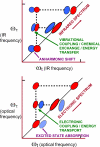Two-dimensional spectroscopy at infrared and optical frequencies
- PMID: 17664429
- PMCID: PMC1964834
- DOI: 10.1073/pnas.0704079104
Two-dimensional spectroscopy at infrared and optical frequencies
Abstract
This Perspective on multidimensional spectroscopy in the optical and infrared spectral regions focuses on the principles and the scientific and technical challenges facing these new fields. The methods hold great promise for advances in the visualization of time-dependent structural changes in complex systems ranging from liquids to biological assemblies, new materials, and fundamental physical processes. The papers in this special feature on multidimensional spectroscopy in chemistry, physics, and biology are typical of many recent advances.
Conflict of interest statement
The author declares no conflict of interest.
Figures






Similar articles
-
Three-dimensional structures by two-dimensional vibrational spectroscopy.Acc Chem Res. 2012 Nov 20;45(11):1896-905. doi: 10.1021/ar3000025. Epub 2012 Mar 29. Acc Chem Res. 2012. PMID: 22458539 Free PMC article.
-
Two-dimensional infrared spectroscopy: an emerging analytical tool?Analyst. 2020 Mar 21;145(6):2014-2024. doi: 10.1039/c9an02035g. Epub 2020 Feb 13. Analyst. 2020. PMID: 32051976 Review.
-
Two-dimensional infrared spectroscopy of peptides by phase-controlled femtosecond vibrational photon echoes.Proc Natl Acad Sci U S A. 2000 Jul 18;97(15):8219-24. doi: 10.1073/pnas.140227997. Proc Natl Acad Sci U S A. 2000. PMID: 10890905 Free PMC article.
-
Applications of two-dimensional infrared spectroscopy.Analyst. 2015 Jul 7;140(13):4336-49. doi: 10.1039/c5an00558b. Analyst. 2015. PMID: 26007625 Free PMC article. Review.
-
Coherent multidimensional vibrational spectroscopy of biomolecules: concepts, simulations, and challenges.Angew Chem Int Ed Engl. 2009;48(21):3750-81. doi: 10.1002/anie.200802644. Angew Chem Int Ed Engl. 2009. PMID: 19415637 Free PMC article. Review.
Cited by
-
A Proposed Method to Obtain Surface Specificity with Pump-Probe and 2D Spectroscopies.J Phys Chem A. 2020 Apr 30;124(17):3471-3483. doi: 10.1021/acs.jpca.9b11791. Epub 2020 Apr 16. J Phys Chem A. 2020. PMID: 32255629 Free PMC article.
-
Correlating the motion of electrons and nuclei with two-dimensional electronic-vibrational spectroscopy.Proc Natl Acad Sci U S A. 2014 Jul 15;111(28):10061-6. doi: 10.1073/pnas.1409207111. Epub 2014 Jun 9. Proc Natl Acad Sci U S A. 2014. PMID: 24927586 Free PMC article.
-
3-picolyl azide adenine dinucleotide as a probe of femtosecond to picosecond enzyme dynamics.J Phys Chem B. 2012 Jan 12;116(1):542-8. doi: 10.1021/jp208677u. Epub 2011 Dec 15. J Phys Chem B. 2012. PMID: 22126535 Free PMC article.
-
From wavelike to sub-diffusive motion: exciton dynamics and interaction in squaraine copolymers of varying length.Chem Sci. 2019 Nov 18;11(2):456-466. doi: 10.1039/c9sc04367e. Chem Sci. 2019. PMID: 34084345 Free PMC article.
-
Excited State Structural Evolution of a GFP Single-Site Mutant Tracked by Tunable Femtosecond-Stimulated Raman Spectroscopy.Molecules. 2018 Sep 1;23(9):2226. doi: 10.3390/molecules23092226. Molecules. 2018. PMID: 30200474 Free PMC article.
References
-
- Ernst RR, Bodenhausen G, Wokaun A. Principles of Nuclear Magnetic Resonances in One and Two Dimensions. Oxford: Clarendon; 1987.
-
- Hamm P, Lim M, Hochstrasser RM. J Phys Chem B. 1998;102:6123–6138.
-
- Mukamel S. Annu Rev Phys Chem. 2000;51:691–729. - PubMed
Publication types
MeSH terms
Substances
Grants and funding
LinkOut - more resources
Full Text Sources
Other Literature Sources

